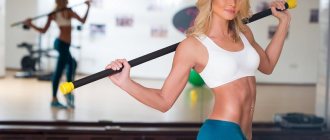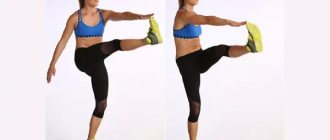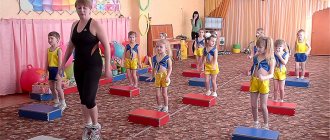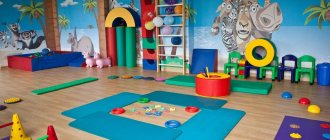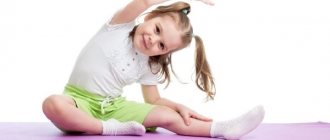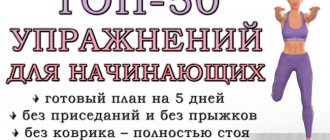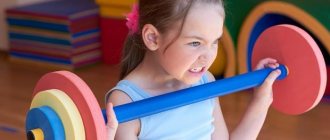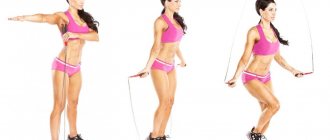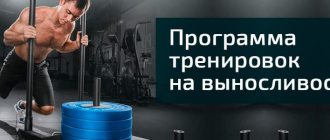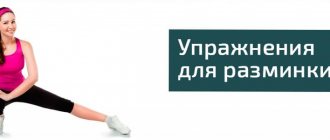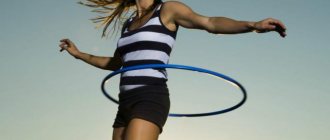- Head tilts.
Flexibility is a critical parameter that is often forgotten. It is this that determines the capabilities of a person’s muscles and its development. With flexible, elastic muscles, the body becomes much faster and stronger in everyday life. Any physical activity can be overcome with ease.
But with age or in the absence of appropriate training, a person becomes less flexible, the muscles seem to become stiff, which negatively affects movements and even posture. In this case, when creating an exercise program for losing weight in the thighs, lower or upper abs and other parts of the body, it is necessary to use elements to improve flexibility.
Why you need to develop flexibility
Elastic muscles and flexibility of the whole body are not only physical development, but also the health of the body as a whole:
- A sedentary lifestyle and constant use of the computer leads to stagnation in the circulatory system, back pain and muscle tension, which negatively affects the functioning of the spine. Performing stretching, even the most basic, allows you to restore blood flow and start all the most important processes in the body.
- Constantly tense muscles increase the risk of injury several times. With more flexible and mobile joints, the risk of various injuries is sharply reduced.
- It has been scientifically proven that the lack of elasticity and flexibility of muscle fibers negatively affects a person’s emotional state. Exercises for stretching the back and other parts of the body relieve not only stiffness, but also stress and moral tension.
If you have led a sedentary lifestyle for many years, the results of stretching will be visible after just a few sessions.
Stretching at home
To make the complex more convenient, use a mat. The presented exercises are aimed at warming up and strengthening the spine, strengthening the thigh muscles as well as the abdominal muscles.
Stretching may not be the most exciting part of your workout, but doing it is just as important to a balanced workout as strength and heart function. Add some flexibility stretching exercises to your workout routine to improve joint, ligament, and muscle mobility, reduce strain, and ultimately make your workouts more effective and safe.
“Tight muscles can cause excessive stress on joints during normal daily activities or damage ligaments,” says Sasha Cyrelson, director of occupational physical therapy at Sicklerville. As we age, our muscles shrink and lose their former elasticity, she adds. “In order to perform any exercise without pain, we must maintain and improve flexibility and stretch the muscles.”
Of course, stretching for adults is neither glamorous nor hardcore, and it probably won't give you the same rush that you'll get from a running class or high-intensity interval training. “It's inconvenient and time-consuming, which is why people don't like it,” Sirelson says. “However, you simply cannot do strength training and cardio without risking injury and pain.” Doing a ton of work contracting (shortening) your muscles and never stretching (lengthening) them will leave them unbalanced. Imbalances in the body increase the risk of injury because they can cause some muscles and joints to overcompensate for others that are under excessive tension. And this leads to tension and discomfort.
Additionally, your muscles are less restricted when they are relaxed and stretched. This allows you to perform a full range of motion (ROM) during training or in everyday life. For example, a greater range of motion in your hips and knees allows you to go lower in your squats. Ultimately, having a wide range of motion results in better quality and more quantity of exercise.
Charlie Atkins, a yoga instructor in New York City, says she likes to use the word “mobility” instead of “flexibility” when emphasizing the importance of doing stretching exercises in everyday life. “For me, it's about everyday things that become more difficult over the years, like bending over to tie a shoe, walking up the stairs, picking up a child off the floor, or even just getting up from the couch.” Improving your mobility makes these daily activities easier—“you can move more freely,” says Atkins.
How to stretch correctly
Before starting the training process, there are several important points to consider:
- We start each lesson with a warm-up. To do this, it is enough to perform a couple of simple movements, for example, jumping rope, running in place. The purpose of the warm-up is to warm up the muscles, normalize blood circulation, and prepare the body directly for the main program.
- We perform all elements of the program slowly, without rushing. Rushing in this case can lead to unpleasant consequences in the form of muscle damage.
- It is important to maintain regularity. We conduct training at least four times weekly. Only regularity and diligence can improve the condition of the muscles, restoring their elasticity and mobility.
- We divide the set of exercises into specific blocks, united by some parameter. Ideally, it is divided into three main groups: for the back, legs and shoulder girdle/arms.
Head tilts
This exercise can easily be classified as a warm-up exercise, but when you do it, you will quickly understand how effective it is in increasing elasticity. The technique is simple:
- We take a standing position - we place our legs at a short distance from each other, our arms are lowered along the body.
- We do an exercise - we alternately tilt our heads in different directions. The choice of direction is determined individually: clockwise or counterclockwise, with alternating sides.
Wrist movements
If you have pain in the arms, you definitely can’t do without this exercise:
- We take the starting position as in the previous element.
- We raise our arms to the sides.
- In this position, we begin to slowly rotate our hands in different directions.
- One cycle consists of several rotations. Then we relax and repeat again.
Note. The “arm rotation” exercise is performed in the same starting position. In this case, we make the movement not with the hands, but with the entire limb.
Stretching exercises from Yulia Barsukova.
Yulia Barsukova is an Olympic champion who is ready to reveal her secrets of good stretching for gymnasts. Her stretching technique is based on familiar rhythmic gymnastics exercises. The main thing is to find the strength within yourself and start practicing.
Exercise 1. Starting position: sit on the floor, straighten your legs in front of you, keep your toes pointed. Performing the exercise: your task is to reach your toes with your hands. Please note that you should not bend your knees. Repeat 10-15 times.
Exercise 2. Starting position: sit on the floor, bring your feet together in front of you and clasp them with your hands. Performing the exercise: you need to place your knees on the floor, this helps stretch the groin area. Perform for 3-4 minutes.
Twist
This movement belongs to a set of exercises with a gymnastic stick. If this equipment is not at hand, you can take any oblong object (even a rolled up large towel will do). Technique:
- We take a vertical position. We take the equipment in our hands with a wide grip.
- We pull our arms completely straight up, then twist the shoulder joints back, pulling them together with the stick.
- We do the required number of repetitions.
Helpful advice. To get the desired effect, we gradually complicate the exercise. To do this, you need to reduce the grip distance with your hands.
A set of exercises for developing flexibility; educational and methodological material
Exercises for the shoulder joints
1. From different starting positions: arms up, down, to the sides, in front of the chest, behind the back, etc. Pulling straight arms back with springy and jerking movements; straight arm swings: unidirectional, multidirectional, simultaneous and alternate; circular movements with bent and straight arms in the lateral and facial planes.
2. Twist the shoulder joints while holding a gymnastic stick in your hands and perform them slowly with a gradual decrease in the distance between the hands.
3. In the “bridge” position, rock back and forth, bending and straightening your legs.
4. Lying in support, bending your legs, springing movements with your torso.
Exercises mainly for the spinal column
1. From different starting positions. Basic stance, legs apart: bends forward, to the sides, back, with various movements of the arms; bending forward with grabbing the legs; body turns; bending in combination with body turns; circular rotation of the body;
2. From a sitting position: legs together, apart, one leg laid aside and bent at the knee: bends forward; bends with leg grips.
3. From different starting positions: main stance, legs apart, kneeling, etc. bending backwards.
4. “Bridge” from a supine position.
Exercises mainly for the hip joints
1. From different starting positions: main stance, legs apart: alternately swing your legs forward, to the sides and back with movements of your arms.
2. From a wide stance, the feet are turned into springy deep squats.
3. From a lunge position forward and to the side: spring squats; squats with torso bends.
4. From a stop, standing legs apart, resting your hands on the floor, spring lowering the pelvis: the same, but one leg is in front, the other is behind. Lowering into splits.
A set of static exercises for flexibility
1) I.P. – lying on your back, bring your legs together, arms along your body:
- leaning on your palms, while inhaling shallowly, slowly raise your straight legs to a vertical position, and then lower them a little;
— while inhaling, jerk your legs up to the vertical and stretch out your toes, supporting your torso from the side with your hands, take a stand on your shoulder blades, your chin should rest on the upper edge of your sternum, do not close your eyes, breathing is voluntary; hold the position from 10 s to 1 min.
2) I.P. - final position of the previous exercise:
- slowly lower your straight legs behind your head, touching your toes to the floor; hold the pose for 10 seconds. up to 1 min.;
- slowly lower yourself onto your back, touching each vertebra to the floor, and also slowly lower your straight legs; take an exercise pose #1, relax.
3) I.P. – lie on your stomach, turning your head to the left or right, arms along your body:
- lie on your stomach with emphasis on your elbows, rest your chin on your fists, bending in the thoracic spine; hold the pose for 10-60 seconds.
Flexibility outdoor switchgear complex with a large rubber ball
(for the preparatory part of the lesson)
1. I. p. - o.s., ball below. 1-2 - right back, bend over - inhale; 3-4 - and. P.; 5-8 - the same on the other leg.
2. I. p. - o. s, ball forward. 1 - release the ball from your hands, squat, at the end of the squat catch the ball; 2 - i. P.
3. I. p. - o. s, ball down. 1-3 - tilt and roll the ball along the floor to the left around straight legs; 4 - i. P.; 5-8 - the same to the right.
4. I. p. - emphasis while sitting behind, the ball on the shins at the feet. 1-2 - raising straight legs, roll the ball towards the body; 3-4-lower your legs and transfer the ball to i. P.
5. I. p. - wide stance with legs apart, arms to the sides, ball on the palm of the right hand. 1 - turn the body to the right, transfer the ball to the left hand; 2 - i. n., ball in the palm of the left hand; 3-4 - the same with a left turn.
6. I. p. - o. s, ball in front of chest. 1 - jumping lunge on the right; 2 - jump into i. P.; 3-4 - the same on the left.
Flexibility outdoor switchgear complex with a gymnastic stick
(for the main part of the lesson)
1. I. p. - stand, stick below. 1 - stick on the chest; 2 - stick up; 3 - stick forward; 4 - rise on your toes; stick up; 5 — stick on the shoulder blades; 6 - stick up; 7 - lower your entire foot, stick forward; 8 - stick down.
2. I. p. - narrow stand with legs apart, stick vertically in front on the floor (support with one hand). 1-2 - squat on the left, right forward, with both hands supporting the upper end of the stick; 3-4 - and. P.; 5-8 - the same, on the right.
3. I. p. - the same. 1-3 - three swings of the right back, leaning on the stick with both hands; 4 - i. P.; 5-8 - the same, on the other leg.
4. I. p. - stand, stick below. 1 - swing left to the side, stick to shoulder to the right; 2 - i. P.; 3-4 - the same, in the other direction.
5. I. p. - stand, stick at the bottom behind. 1 - bend forward, touch the floor with a stick at the heels; 2 - i. P.; 3 - bend forward, swing the stick back; 4 - i. P.
6. I. p. - emphasis on the knees with hands resting on a stick. 1-2 - hold the ends of the stick vertically, turn the body and head to the left; 3-4 - and. P.; 5-8 - the same, in the other direction.
7. I. p. - lying on your back, stick at the top (on the floor). 1-2 - lying tuck, stick on the shin near the insteps; 3-4 - and. P.
8. I. p. - gray hair, stick on chest. 1 - sit at an angle, stick to toes; 2 - swing the legs apart onto the stick; 3 - the same, back; 4 - i. P.
| № | Contents of the exercise | Dosages ka | Organizational and methodological instructions |
| 1. | I.p. - stand with your legs apart, hands on your belt. 1-3 - 3 springy tilts of the body to the left, right arm up, 4 - i.p., 5-7 - 3 springy torso tilts to the right, left arm up, 8-i.p. | 8 times | Keep your arm straight at the top. |
| 2. | I.p. - sitting on the floor. 1-3 - 3 spring forward tilts, 4 - i.p. | 6 times | Reach your chest with your knees, keeping your legs straight. Bend forward with the help of a teacher who presses his hands in the area of the shoulder blades. |
| 3. | IP - gray haired on the floor. 1-3 - emphasis lying behind, bending over. 4 - i.p. | 6 times | |
| 4. | IP - gray haired on the floor. 1 - sitting with legs bent, 2- lift your pelvis off the floor 3-4 – i.p. | 6 times | Try to touch your heels with your buttocks, arms straight. |
| 5 | I.p. – lying on your stomach, on the floor, arms bent at your chest. 1-4 – slowly straighten your arms, bend over, 5-8 - i.p. | 6 times | |
| 6. | I.p. - lying on your back, arms along your body. 1-3 - lift your right leg up, grab it with your hands, smoothly pull it towards your body, 4 - i.p. 5-7 - raise your left leg up, grab it with your hands, smoothly pull it towards your body, 8-i.p. | 6 times | |
| 7. | I.p. - stand with legs apart. 1- right hand up, left hand down, 2-3 - bend your arms back and connect your fingertips, 4-i.p. | 6 times | |
| 8. | I. p. - stand with legs apart. 1-4 - circular movement of the body to the right, 5-8 - circular movement of the body to the left. | 6 times | |
| 9. | I.p. - lying on your stomach, legs apart, grab your shins with your hands from the outside. 1-2 - bend in the back, 3- stay in this position for 2-3 s, 4- i.p. | 6 times | |
| 10 | Standing facing the gymnastics wall, place your right foot on the bar at waist (or chest) height and, leaning forward, strive to touch your leg with your chest. | 10 times |
A set of static exercises for flexibility
1) I.P. - sit on the floor, legs forward, then bend your left leg at the knee and press the sole of your foot to the inner surface of your thigh so that your heel is near your groin and your knee is pressed to the floor.
— while inhaling, lean forward and grab your left (right) foot with your hands;
- tilt your head forward and rest your chin on your sternum, keep your back straight;
- take a deep breath and hold your breath. Try to pull in your buttocks and stomach;
- hold the pose while holding your breath for 0.5-1.5 minutes, then relax and inhale, protruding your stomach, repeat the breathing cycle 1-2 times;
- exhale, raise your head, lower your feet with your hands, raise your torso to the vertical and straighten your bent leg;
- perform the exercise on the other leg, then lie on your back and relax.
2) I.P. – sitting on the floor, legs extended forward, then take the left leg to the side and bend at the knee joint so that the left thigh is perpendicular to the right leg:
— while exhaling, bend over with your right side, grab the toes of your right foot with your left hand, and place your right forearm on the floor along your right shin. Hold the pose for 10 -30 seconds;
- straighten your torso, grab your left knee with both hands and, as you exhale, bend towards it, falling lower and lower;
— fix the torso in a maximum tilt for 10-30 seconds and then straighten it.
3) I.P. – sit down, legs forward: pull your feet towards the perineum, bending your legs at the knee joints; connect the soles of your feet and lower your knees; pressing your elbows and forearms on your shins, press your knees to the floor; inhale, as you exhale, bend down and then lower your head, trying to touch your forehead to the floor; hold the pose for 1-2 minutes.
Spread twine.
The spread split is an unrivaled muscle stretching exercise for rock climbers and ballet dancers. Once you have gained some skill in performing the “seated groin stretch,” you can carefully shift your body weight to your elbows. Your hips will be raised relative to the floor and your legs will form a straight line when viewed from above. Slowly transfer your body weight to your legs and “press” your feet onto the floor. When the tension is relieved, the legs will move apart a little more to the sides. Shift your body weight to your elbows and “push the walls” with your legs even further. Bending your knees while performing any type of straight (transverse) split leads to injuries and damage.
Picture 1
Stretch your arms forward, lie flat on the floor, in this “spread out” position you can turn your upper body to the sides from time to time to slightly increase the range of motion.
Straight (transverse) twine.
“Dead split,” this is what special forces call in Russia a straight (transverse) split with the toes of the feet pointing forward.
Figure 3
“Push the walls” and – this is very important – push your hips forward. Three positions for hand support are offered. You can give the correct position to the hips in a position with support with one hand in front and the other behind relative to the body; you can lean your hands on the floor in front of you and pull your hips forward; or, if there is enough flexibility, then moving your arms back for support, behind your back, pushing your hips forward.
Exercise.
Starting position: sitting in a cross split, move your right arm to the side, then up and grab your left foot. The left hand is pressed to the floor and extended towards the right leg. Hold for 20-30 seconds, then do the same in the other direction.
Figure 3
Longitudinal twine.
- Get down on one knee. Look forward, keep your pelvis straight. Stretch your spine upward, “opening” your chest as you inhale.
- As you exhale, bend forward and lower your hands to the floor. Stretch your entire spine without straining your shoulders and neck.
- Take a breath. As you exhale, slowly slide your front leg forward, transferring the weight of your body to your arms. Move your pelvis forward as far as possible, straighten your back leg. The back knee should be directed towards the floor, the forward knee should be directed towards the ceiling.
- Lower your pelvis and take a few breaths. Raise your arms above your head, placing your palms together. Pull the back of your body up. Stay in this position for a few seconds before relaxing. Return to the starting position and repeat, changing the position of your legs.
Figure 4
Exercise.
- Lie on your stomach, on the mat, bend your right leg under you, left leg straight. Place your hands on the floor and lift your torso. Keep your pelvis straight so that your lower back only stretches slightly.
- Bend your left leg. As you inhale, stretch your entire spine up and back. Extend your right arm above your head and, as you exhale, grab your left foot.
- Holding your left foot tightly, raise your left hand above your head and also grab your foot with it. As you exhale, bend your thoracic spine, stretch your neck and tilt your head back until the crown of your head touches your foot. Stay in this position for a few seconds, then lower your arms one by one. Inhale and slowly raise your head.
Figure 5
Exercise.
- On your knees, reach up. Moving your head back, bend back, arching your thoracic spine and “opening” your chest.
- Continue stretching backwards with your arms bent. Do not tilt your pelvis back so that the weight rests on your knees and feet. Stretch slowly, controlling your movements.
- Grasp your feet with your hands, chest “opened”, pelvis still pushed forward. Bend over so that your head rests on your feet and your elbows on the floor. Stay in this position for a few seconds, then return to the starting position.
Figure 6
Exercise in the dog position.
Angle emphasis on legs and arms. From a kneeling position, straightening your legs, move to a point-blank position - your torso and head are on the same line.
Options:
A – Performed on one leg, the other bent. B – On one leg, the other up.
Figure 7
Side bends
This is one of the highly effective exercises for stretching muscle fibers. It is performed as follows:
- We stand up straight, placing our hands on our sides.
- Pull one arm up, fully straightened. We move it to the side, simultaneously tilting the body and moving as if under the action of a spring.
- Next, we take the starting position, change hands, and repeat the exercise in the other direction the required number of times.
Swing your legs
Flexibility and elasticity are important not only in the arms and torso. Legs also need to be trained. With this exercise you will quickly restore muscle tone:
- We stand sideways to the support, leaning our hand on it. It could be a chair, a machine, a table. The main condition is that the equipment must be placed at waist level. Otherwise, there will be no effect from execution.
- We swing with a leg that is not blocked by a support.
- First we make movements back and forth, then sideways.
- We change position - we rest on the other side, and repeat the movement the required number of times with the other leg.
Interesting facts about flexibility
By putting together a full set of exercises to develop flexibility, your body will experience a huge positive impact from such physical activity. It would seem that these are simple elements, but what is the effect as a result. If you're still wondering whether or not to include these exercises in your training program, be sure to check out these interesting facts about flexibility:
- The mobility of the joints of the human body develops up to 14 years of age. By the age of 17, complete stabilization occurs. Then the regression begins.
- Before 9 am the body is less flexible than at other times. But it is during this time frame that the benefits of performing the appropriate exercises are higher.
- As the temperature rises, the flexibility of the body increases. When it goes down, it decreases.
- Due to anatomical features, women are much easier to do longitudinal splits. Men sit on the transverse one faster and easier.
- The flexibility of the right and left sides of the body is significantly different.
- The effectiveness of stretching is felt after just 30 seconds of performing the appropriate exercises.
The benefits of stretching + exercise rules
Below is a ready-made set of stretching exercises that you need to perform 1-2 times a week if you want to keep your body healthy and mobile.
10 important reasons to stretch:
- Relief from stiffness and stiffness in muscles and joints.
- Prevent muscle shortening.
- Improving the elasticity of muscles, ligaments and tendons.
- Prevention and relief from spinal problems.
- Improving posture and getting rid of stooping.
- Improved flexibility and coordination of movements.
- Relief from muscle fatigue.
- Reduces the risk of injury and sprains.
- Psychological adaptation to physical activity.
- Reduce stress and increase vitality.
The structure of this stretching workout:
- Joint gymnastics (5-6 minutes). Be sure to do joint exercises before stretching. If you plan to stretch after an active workout, then you can skip the joint exercises and go straight to stretching.
- Stretching exercises (25-30 minutes). All the exercises suggested below are static, that is, you take a pose and stay in it for 30 seconds, stretching the muscles. If you want to shorten the stretching time to 15 minutes, then hold each pose for 15 seconds. If you want to extend the length of your stretch to 40 minutes, hold each pose for 45 seconds.
Duration of stretching exercises:
- 30 seconds in each pose => total stretch duration ~25 minutes
- 45 seconds in each pose => total workout duration ~35 minutes
- 15 seconds in each pose => total stretch duration ~12 minutes
How often to perform a set of stretching exercises:
- For active trainees: once a week for 30 minutes (in addition to regular short stretching after training)
- For people leading a sedentary lifestyle: 2 times a week for 30 minutes
- For people who want to improve their stretching and flexibility, as well as get rid of back pain or improve posture: 3-4 times a week for 30 minutes
- For people who practice yoga on a regular basis, additional stretching exercises may not be necessary.
Rules for performing stretching exercises:
- All proposed stretching exercises are static (except for joint gymnastics). To perform them, you need to take a given pose and stretch the muscles in one position.
- Remember to do stretching exercises on both the right and left sides.
- You can always deepen the position or, conversely, simplify the stretching exercise a little by choosing a more comfortable position. Listen to your body!
- Exercise without sneakers, barefoot or in socks. Additionally, you will need a mat (preferably non-slip).
- If some stretching exercise gives you severe discomfort (not discomfort from stretching the muscles, but, for example, pinching, cramping or pain), then it is better to stop doing this exercise.
- Hold each pose for 30 seconds on each side (in which case the total stretch duration will be 25 minutes) or 15 seconds on each side (in this case the total stretch duration will be less than 15 minutes).
- It is advisable to use a timer to track the duration of the static pose. Check out our selection of mobile timer apps.
If you do not have a mobile application with a timer, then use a ready-made video with a sound signal every 30 seconds: follow the link.
Ready-made training plan for girls at home:
- Mon: Workout for hips and buttocks
- VT: Interval training for weight loss and body tone
- CP: Low-impact cardio without jumping
- CT: Upper Body Workout
- PT: Circuit training for problem areas
Other workout plans for girls:
- Workouts for Brazilian buttocks: 3-day program
- Full body workout without jumping: 3 day program
- Ready-made training plan for women over 40 years old
- Strength program for girls with dumbbells: 5-day plan
- Program for losing weight on legs (for pears): 30 exercises + plan
Ready-made training plans for men:
- Ready-made strength program with dumbbells for 7 days
- Ready-made program for losing belly fat without equipment (for 3 days)
- Ready-made program for the whole body without equipment (for 3 days)
- Ready-made split training program with dumbbells (for 3 days)
Other collections of stretching exercises:
- Top 100 Stretching and Flexibility Exercises + 8 Day Plan
- Top 50 stretching exercises for splits from scratch
- op-15 stretching exercises for the upper back and cervical region
- Top 10 simple exercises to relax your lower back
